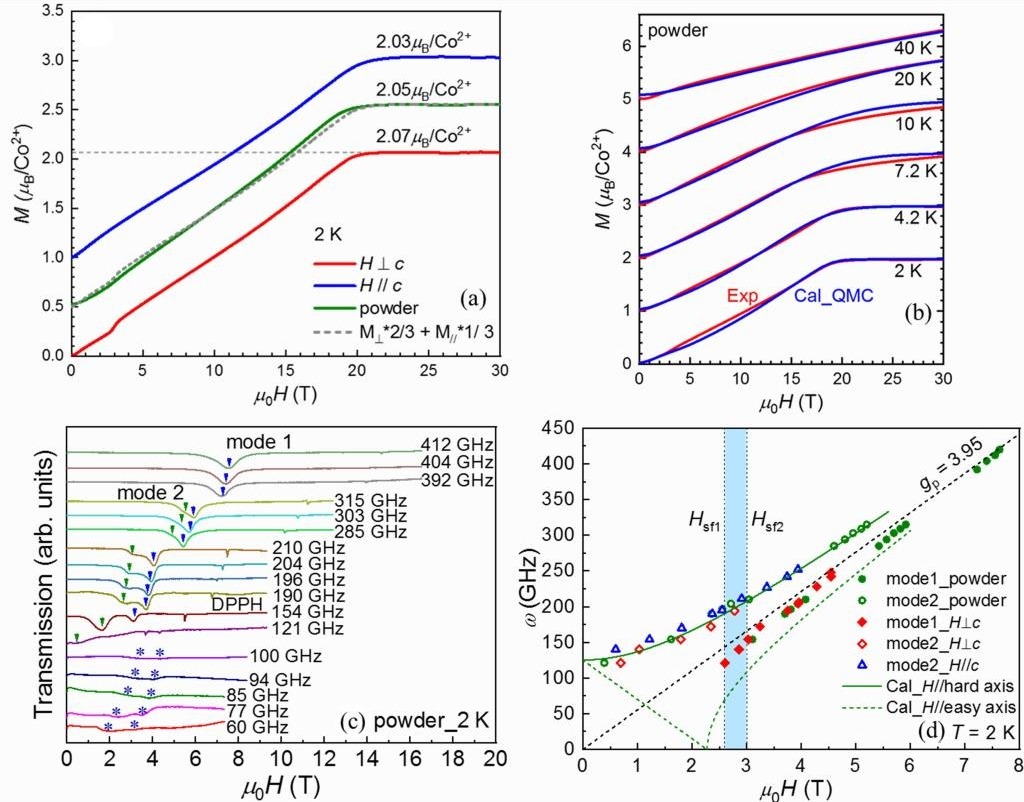
Pulsed high-field magnetization M(H) and magnetic field dependencies of the ESR spectra as well as the frequency-field (f-H) relations.
Background
Quasi-one-dimensional antiferromagnetic spin systems often exhibit exotic ground states and magnetism due to quantum fluctuations and reduced dimensionality.Recently, S= 1/2 spin-chain compound composed of cluster has also aroused the interest of physicists. In this paper, we have synthesized successfully single crystals of the Co-based Seff = 1/2 compound BaCo2(SeO3)3·3H2O with dimer-chain structure.
What we discover?
In this paper, we performedhigh magnetic-field magnetization and ESR measurements for the single crystal and powder samples.Our results show that the compound is antiferromagnetically ordered at 7.6 K. The magnetization curve exhibits a spin-flop transition within 2.6–3.0 T (H⊥c) followed by a nearly linear increase in magnetization until saturation at about 22 T.The intradimer and interdimer interactions are estimated.
Why is this important?
According to our results, BaCo2(SeO3)3·3H2O is approximately a three-dimensional antiferromagnet, although structurally it contains dimer chains, which shows easy-axis anisotropy. The magnetization process can be described withthe intradimer exchange J1= −20.0 K and the interdimer exchanges J2= −14.6 K and J3= −6.2 K.Our study provides new insight into the magnetism of magnetic materials with coupled spin-dimer structure.
Why did we need WHMFC?
The facilities of high-field high-frequency ESR and thehigh-field magnetization up to 30 T developed in the WHMFC were used to detect themagnetic properties for powder and single crystal sample,which are useful to study the anisotropy of the magnetic materials.
Who did the research?
X.C.Liu,1Z. W.Ouyang,1T.T.Xiao,1J. J. Cao,1Z. X.Wang,1Z. C. Xia,1Z.Z. He,2and W. Tong3
1Wuhan National High Magnetic Field Center & School of Physics, Huazhong University of Science and Technology,Wuhan430074,P. R. China.
2State Key Laboratory of Structure Chemistry, Fujian Institute of Research on the Structure of Matter, Chinese Academy of Sciences, Fuzhou 350002, People’s Republic of China.
3Anhui Province Key Laboratory of Condensed Matter Physics at Extreme Conditions, High Magnetic Field Laboratory, Chinese Academy of Sciences, Hefei 230031, P. R. China.
Acknowledgments
This work was supported by the National Natural Science Foundation of China (Grant Nos. 11874023 andU20A2073) and by the Fundamental Research Funds for the Central Universities (Grant No. 2019kfyXKJC008)
Link:https://doi.org/10.1103/PhysRevB.105.134417
